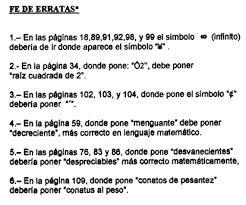Instructional Text Example
Spanish Classes / / July 04, 2021
The instructive texts They are that refer to the sequence of instructions on how to carry out a certain action, its complexity varies depending on the object to be manipulated or the actions to be carried out.
Using an electronic device, putting together a piece of furniture, taking some medicine, doing a task, cooking recipes, even the instructions that we should follow in the event of an earthquake, they all have something in common and that is that they are accompanied or are part of a text instructive.
Structure of an instructional text
- Qualification.
- Summary of the elements that will be used, this is where the name of each of these is exposed and if it has any specific or general function.
- Instructions, in an organized sequence.
Instructional text features:
- Clarity and precision of the indications, these must have a simple and adequate language that must be understood by anyone who intends to use the product.
- Write the sequence of activities in a correct and understandable chronological order, list them and use connectors that help to understand the actions: “First connect”, “once you connected the blue wire”.
Types of instructional texts:
- Assembly manual
- Repair manual
- Cooking recipe
- Travel Guide
- Medical prescription
- Regulation
Examples of instructional texts:
1. Instructions for using itunes on a computer:
1.- Open the main page of Apple.
2.- Register as an Apple user (in case of not being previously registered).
3.- Search for “Itunes” in the search section found in the upper left corner.
4.- Once the search engine has returned the results, click on Itunes.
5.- Download the program by clicking on “donwload”.
6.- A download window will appear, in which you must click on the "execute" button.
7.- Wait for the download to finish.
2. Spaghetti with shrimp cooking recipe instructions:
2 envelopes of spaghetti.
1 bottle of natural cream.
1 minced garlic
500 gr. Shrimp.
Butter.
1.- The first step is to heat the spaghetti, you leave it to simmer for about half an hour.
2.- Once the spaghetti is “al dente” (this means neither too hard nor too soft), you chop the garlic into fine pieces, the which you add to a saucepan along with 2 tablespoons of butter, let it sew for 5 minutes or until the butter is melted.
3.- Once the butter has melted, add 1 cup of natural cream, and leave it for 2 minutes.
4.- Later you add the spaghetti and stir.
5.- Once the spaghetti is ready, add the shrimp.
3. Instructions on how to make homemade soap:
Ingredients
Fat: Lard Coconut oil.
One and a half liters of filtered water.
300 grams of acoustic soda.
Kilo and a half of lard or, where appropriate, coconut oil.
7 milliliters of aromatic oil.
10 drops of pastry coloring (color to taste).
Tools needed for preparation
Rubber or latex gloves.
Knife.
Plastic mold.
Graduated jar or jar for measuring.
A pan.
Plastic or wooden spoon for stirring.
Cleaning cloth.
Clean basins.
Metal tray or tray and metal spoon.
Bogles or glasses to protect the eyes.
Instructions:
Step 1
With the graduated pot, measure the water and place it in a pot, and put it to heat but not boil.
Step 2
Pour the hot water into one of the buckets
Step 3
Put on rubber or latex gloves and goggles.
Step 4
Pour the acoustic soda into the bucket with hot water.
Step 5
Gently stir the hot solution with the plastic (or wooden) spoon.
Step 6
Heat and melt the lard or coconut oil, taking care that it is not boiling).
Step 7
Carefully pour the melted butter into the other basin, then carefully drain the water with acoustic soda in the bucket with the melted fat and stir it adding the aromatic oil and the colorants.
Step 8
Stir the ingredients carefully, looking for the exact point, otherwise the mixture will "cut".
Step 9
Pour the mixture into the plastic mold.
Step 10
Wait thirty forty minutes to rest the mixture in the plastic mold and if oil comes out on top, remove it carefully with the metal spoon.
Step 11
Let it rest for several hours until it cools and "solidifies" (by then it will have changed color) to be able to carefully transfer it from the mold to the metal tray or tray.
Step 12
With the knife, polish the slags and protrusions that may have remained after the extraction of the mold.
Step 13
The soap is not yet ready to be used, for this it must be “cured”, this is done by wrapping it with a towel or cloth for seven days, after which it will be ready to use.
Step 14 (optional).
If you are not satisfied with the shape you obtained when you took them out of the mold, you can shape it using with Take care of the knife, by this time the result obtained should be a foamy soap with fragrance.
- More: Examples of instructions.



